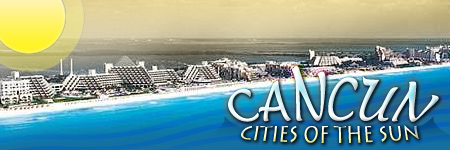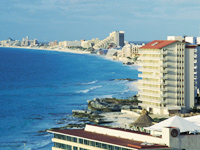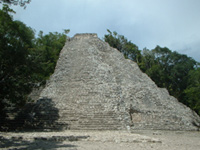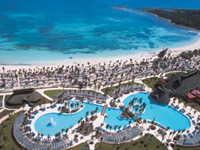
Cancun, Mexico - A Tour Through Mayan History
by Sean O'Reilly
Cancun became a popular tourist destination in the 1970s, and at the same time, the ancient Mayan City of Cobá, which may have lain in ruins for ten centuries, slowly found a place in the annals of sites that must be seen. Cobá is about 45 miles east of Chichen Itza and about 20 miles west of Cancun and the Mayan Riviera, in the Mexican State of Quintana Roo. About an hour’s journey by bus, many excellent tour guides to local archaeological sites are available at hotels up and down the Cobá coast.
 |
Cancun's Resort-Lined Coast |
Cobá means “waters stirred by the wind” as the city was built between two lakes. The presence of abundant fresh water and fish (there are five lakes all told in the area) was likely a pivotal consideration in the establishment of the site around 500 AD. At the high point of Cobá’s influence as many as 50,000 Maya may have lived in the city, which had grown by that time into an area of approximately twenty-five square miles. Most of the city is still completely unexcavated, unlike Chichen Itza and the seaside ruins at Tulum, which have been both excavated and reconstructed. A great place to begin to engage the history of the Mayas, Cobá is still largely unexplored. It's a place to imagine the past as it may have been and reflect on the religion and culture of the Mayas.
At the high point of Cobá’s influence as many as 50,000 Maya may have lived in the city, which had grown by that time into an area of approximately twenty-five square miles. |
The Mayans worshipped a variety of Gods but the Sun and Moon Gods seem to have been the most important deities. Cobá might be thought of as a city that represented some sort of architectural harmony between the Sun and the weather Gods. Temples with platforms reaching into the heavens could have only signified a kind of doorway or path to the heavens. The temple platform of sacri-fice was surely a place closest to the Sun God. Is it any wonder then that today sun worship continues in the Yucatan with hordes of vacationers worshipping in the golden rays of the Mayan sun?
The pyramid temple of Nohoch Mul at Cobá is one of the tallest in the Yucatan peninsula and is, at the present time, one of the few that visitors can still climb. At 138 feet and very steep, it is an exhilarating climb with fabulous views of the nearby lakes and jungle canopy. For those who are unsure of their footing, a rope runs down the middle of the temple for safety. Indeed a visit to Cobá, Tikal or Chichen Itza can help break the tedium of too much fun, sun and food. A visit to these sites and their magnificent temples help make the achievements of the Mayas real to young and old alike.
First discovered by Westerners in 1892, Cobá was not officially investigated until the 1920s by J. Eric S. Thompson of the Carnegie Institute. Today, there are thought to be over 6,000 structures still covered in jungle vines and trees at the site. In fact,
a five thousand ton rolling cylinder was recently discovered that the Mayans appear to have used (much like we use a steam roller) to compress their crushed rock and limestone roads. These roads known as “sache” run in some instances for nearly sixty-two miles in a straight line. There are approximately fifty such roads of varying length that have been discovered. The Mayans apparently did not know about or use the wheel, so the roads may have been reserved for foot traffic and religious pilgrimages.
Their building techniques, which included an extensive use of stucco and cement more long lasting than our own, and astounding astronomical and mathematical expertise indicates a civilization that was dynamic and extensive.
 |
Nohoch Mul in Cancun |
Our present lack of understanding as to why the Mayas abandoned Cobá in 1000 AD and then re-populated the city, in a more limited way, 100 years later is largely due to the missionary zeal of the Jesuits who believed the Mayan books were works of the devil and burned them. Given the Mayan penchant for blood sacrifice, the Jesuits’ revulsion for the Mayan priests and any writing associated with them, while historically lamentable, is perhaps understandable. They believed they were saving the Maya from everlasting damnation, a belief perhaps no less extreme than the notion that the Sun required human blood for sustenance.
There may be a simple reason that the Mayas abandoned Cobá around 1000 A.D but scientists have yet to uncover it. Civil war and anarchy have been advanced as possible theories, along with overpopulation and subsequent squabbling over declining natural resources but no one really knows what happened at Cobá.
We do know, however, what is happening today on the Mayan Riviera, which is a magnificent, 65-mile stretch of white sand on the east coast of the Yucatan peninsula. The development of new hotels and the repair of buildings damaged by recent hurricanes is continuing at a blistering pace. These new temples to the sun would have astonished the ancient Mayan builders who, no slouches themselves, built bold and imaginative structures that were designed to last.
Respect for the arts of the Mayan civilization is being reborn in pleasing new permutations of style in hotels on the Mayan Riviera. Is it any wonder that the Mexican and Central American people have taken so well to the construction industry throughout the Americas? They have a centuries-old tradition of great building projects handed down by the Mayans, Incas, Toltecs and the Aztecs that is by now rooted in the genes.
Resorts such as Barceló’s new Tropical Beach Hotel and Colonial Beach Hotel have taken their architectural accents and art from the Mayan culture and then added creative flourishes such as the life-size stone angels that decorate the hallways of each building. The Mayan architectural spirit continues on in the dedication of hotel employees such as the vivacious Tania Gonzalez of the Barcelo Tucancun Beach and other executives who have been known to don hard hats and pitch in to help restore the hotels they love.
The Riviera Maya, also known as the Mayan Riviera, runs between the resort city of Cancun to the north, and continues down to the Mayan ruins of Tulum to the south. The Riviera Maya is part of the Mexican Caribbean, which describes the east coast of Mexico from Cancun down to Quintana Roo's capital city of Chetumal, and the southern border with Belize, Central America. The island of Cozumel, Mexico's largest island, is also considered to be part of the Mayan Riviera.
There are many fine properties on the Mayan Riviera. Top picks recommended by travelers would probably be the Ritz Carlton and the JW Marriott in Cancun, and the Barceló Maya Beach Resort south of Cancun. I stayed at the Barceló Maya Colonial Beach, located right on the best beach in the Mayan Riviera, on the Mexican Caribbean coast. Its magnificent facilities are surrounded by a lush 500,000 square-meter natural park complete with an ATV course and horse rides.
 |
Cancun's Barceló Maya Beach Resort |
The Barceló Maya Beach Resort sits half way between two of the area’s most significant Mayan ruins, Chitzen Itza and Tulum. Day tours can be arranged from the resort, as well as rental cars for those who want to explore on their own. Together with three hotels, it forms part of the Barceló Maya Beach Resort. Through the "Barceló All Inclusive" package, one of the most comprehensive in the Caribbean, it offers an excellent variety of facilities and services that will make your stay an unforgettable one. There are lots of activities for young and old alike. I particularly enjoyed the outdoor gym housed in an open thatched fale and the nightlife in the nearby town of Playa Del Carmen.
You might, of course, also spend a great deal of time doing absolutely nothing in these cities of the sun except, perhaps, reflecting on their magnificent cultural history and enjoying every minute of it.
Sean O'Reilly is the Editor-at-Large for www.travelerstales.com.
Widely traveled, Sean most recently completed a journey through the islands of the South Pacific and Malaysia. He lives in Virginia with his wife and six children.
|